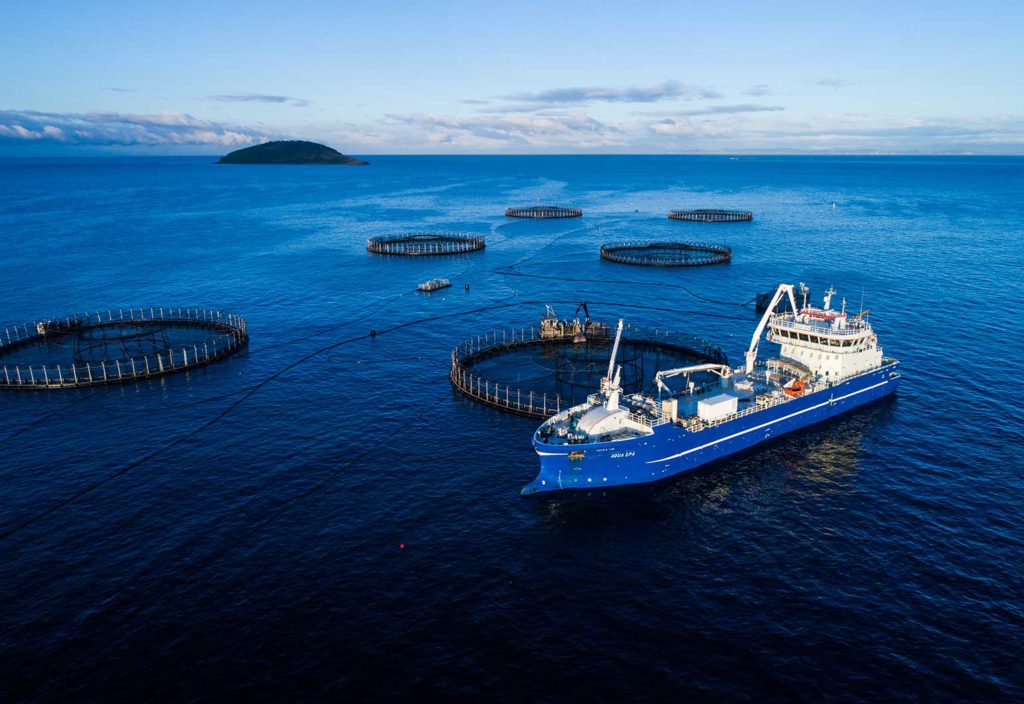Bringing together expertise in marine engineering, renewable energy and aquaculture, a new cooperative research centre aims to transform the way we use our oceans — and tap into a lucrative market.
The Federal Government’s National Aquaculture Strategy aims to double the value of aquaculture production to $2 billion by 2027, but a lack of suitable near-shore production sites is preventing growth.
The solution? Go offshore, taking advantage of Australia’s exclusive economic zone — the third-largest in the world — which is home to some of the world’s best offshore energy resources, as well as tropical, sub-tropical and temperate water environments that are all capable of supporting seafood production.
But a lack of expertise in offshore aquaculture — including building and maintaining infrastructure, energy availability, supply chain logistics and biosecurity — is preventing progress.

Addressing this is a key focus for the Blue Economy CRC, based on the University of Tasmania campus in Launceston, Tasmania and launched mid-last year. By bringing together a diverse group of researchers and industry partners, the centre hopes to achieve some lofty goals, including making seafood production one of Australia’s top three primary producing sectors by 2040, worth more than $5 billion a year.
“Our vision is for Australia’s ‘blue economy’ industries (in offshore sustainable seafood and co-located renewable energy) to be globally competitive, at the forefront of innovation and underpinned by a robust environmental planning and management framework that is trusted and valued by consumers,” CRC Research Director Professor Irene Penesis told create.
“The ongoing need to feed, house and produce sufficient energy to support our growing world population underlines the importance of the blue economy, which seeks to provide solutions for the sustainable use of the world’s ocean energy resources.”
Working with industry
Penesis, a mathematician with a background in hydrodynamics and marine renewable energy, led the bid to develop the CRC after recognising that advances in the blue economy could be accelerated by bringing together renewable energy and seafood production.
“Many of the challenges of moving offshore are similar and are better understood and addressed if these sectors work together to conduct research and explore co-location benefits,” she said.
“Our current 40 partners from nine countries include CSIRO, universities and many industrial partners, offering world-leading research and development strengths to maximise Australia’s role in a global shift to a sustainable blue economy.”
The CRC launched with five major research programs: Offshore Engineering and Technology, Seafood and Marine, Offshore Renewable Energy Systems, Environment and Ecosystems, and Sustainable Offshore Developments. It commissioned 17 short-term scoping projects earlier this year, spread across the five themes, which will guide the CRC’s future activities, and has also approved a number of larger research projects that will run for up to three years.
These long-term projects include developing, testing and demonstrating a novel energy storage element, the mooring tensioner, to enable the use of rotary electrical generators for wave energy converters, and creating a pure-DC hydrogen microgrid for use in experiments aiming to understand and resolve issues in a marine setting.
“We are testing new models, technologies and creative approaches to offshore production by combining forward-thinking industry partners with some of the world’s best researchers to deliver innovation in sustainable offshore seafood and renewable energy systems,” Penesis said.
“The Blue Economy CRC’s research agenda has been ‘co-created’ with industry partners to ensure it delivers value, and assists all participants to face their challenges in achieving scale and commercial success in the offshore environment.”
Working with industry is a vital part of the CRC’s work, and Penesis’ role is likely to evolve over the life of the centre, moving from research to technology transfer, path to market and commercialisation of the CRC outcomes after the first three years.
Engineering a new economy
Engineers are central to the CRC, providing experience in renewable energy, remote monitoring technology, shipping, defence, and oil and gas industries.
One such engineer is Professor Chien Ming Wang from the University of Queensland’s School of Civil Engineering, who became involved after a colleague heard about his interest in floating fish farms and introduced him to Penesis. Now, he’s heading up the Offshore Engineering and Technology program.
“This program aims to generate the infrastructure that will support the development of offshore systems,” Wang told create.
“It brings together industrial engineering expertise to collaborate with the aquaculture and offshore renewable energy sectors, to design and build infrastructure and autonomous technology for integrated offshore aquaculture farms and renewable energy generation systems.”
Wang and his team are currently carrying out scoping studies on fish pen designs and mooring systems, multipurpose floating platforms, autonomous technology for aquaculture and offshore renewable energy production and storage.
“These studies will allow us to identify key concepts, technologies and technological gaps,” he said.
“The next step is for the multidisciplinary research teams to formulate directions for future ground-breaking research and development of next generation offshore fish farms and renewable energy production systems. Conceptual designs will be shortlisted for further analysis, design, model testing and finally for prototyping.”
The outcome of this research could be the development of a commercial offshore fish farm that is automated and has its own power supply.
“The program will also build a strong core of experts in offshore aquacultural engineering, offshore renewable energy engineering and offshore infrastructure engineering, which is essential for Australia’s development and utilisation of her large sea space in the most productive and sustainable way,” Wang said.
While some of his engineering colleagues are confused why a structural engineer would be interested in offshore fish farms and fish production, Wang said it made total sense.
“I explain to them that fish pens, floating breakwaters, moorings systems, floating platforms and raft wave energy converters are all structures,” he said.
“Structural engineers need not be confined to working on land-based structures. By collaborating with engineers from other disciplines, structural engineers can work on all forms of structures in different kinds of environments, from underground structures, to marine structures, to space, biomedical, and even nanostructures.”
